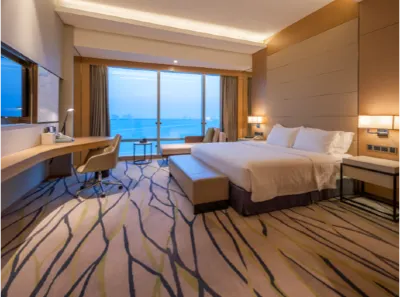
Best Yerevan Hotels
Enter your dates for prices and availability of the best hotels in Yerevan.
Swipe up to view more
Filter by:
Hotel Star Rating
≤2345
Guest Rating
Amazing 9+Great 8+Good 7+Pleasant 6+Popular Filters for Yerevan
Breakfast includedHotelGreat 9+PoolRepublic SquareWithin 1 km1 double bedZvartnots International Airport(EVN)Free cancellationHotelsProperty Type
HotelServiced apartmentResortApartmentGuest houseVillaBed and breakfastVacation homeLodgeHomestayInnHostelCapsule hotelProperty facilities & services
Pool24-hour front deskCurrency exchangeWi-Fi in public areasSpaSaunaGymParking availablePets welcomeWater parkElevatorFree parkingLaundry roomSmoking areaLuggage storageCar rentalsRestaurantEV charging stationGolf courseBarWake-up callConference roomBarbecueairport transfersFree airport transfers306 Best Hotels to Stay in Yerevan
Find great hotels in Yerevan on Trip.com! Read guest reviews, compare the latest prices, and explore hotel details to choose your perfect stay.
Most Booked
Lowest Price
Closest to Downtown
Highest Rated

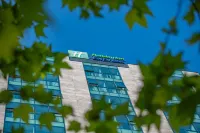





99+
Hotels in Yerevan
Executive lounge
Public parking
24-hour front desk
+11
"Nice hotel centrally located not far from republic square (10 to 15 minutes walk). Breakfast is good with various choices. Rooms are small but equipped with almost all the utilities you need like fridge, electric cattle, hairdryer, safety deposit box, ironing board and iron. Also they provide free bottled water every day."
Amazing
114 reviews
9.4/10
1 night
From 117 AZN
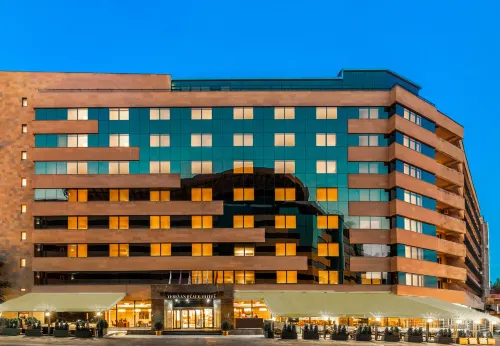






85
Hotels in Yerevan
 No. 10 of 4-Star Select Hotels in Yerevan
No. 10 of 4-Star Select Hotels in YerevanMassage room
Gym
Parking
+13
"The location is great, right near Republic Square. The service was excellent and friendly. The breakfast was varied and satisfying! The room was also quite large, well-equipped, and clean!"
Amazing
57 reviews
9.6/10
1 night
From 118 AZN
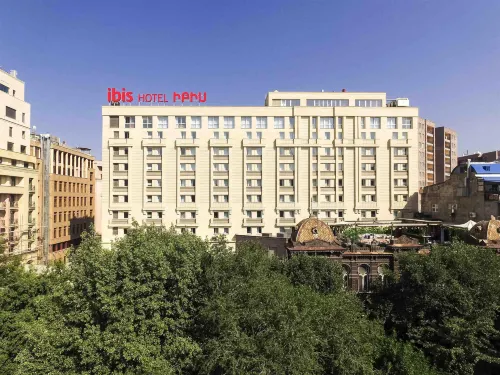
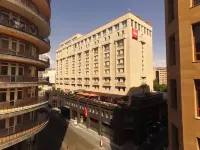





67
Hotels in Yerevan
Private parking
EV charging station
Airport pick-up
+12
"Great location just off north avenue.. A customer oriented team who agreed to give me the room early cuz simply it was available rather than asking for early check in money
Small room of course but clean and adequate.. Didn't try breakfast but I tried their Terrace cafe and it was great..and it's 10% cheaper than North avenue hotel which is 20 meters away"
Very Good
84 reviews
8.9/10
1 night
From 104 AZN







87
Hotels in Yerevan
Public parking
24-hour front desk
Luggage storage
+3
"It's located in the city center, so it's easy to get to anywhere. The front desk staff were very helpful. The shower water pressure was sometimes weak, but the temperature was comfortable. There was no shampoo, only body soap."
Great
102 reviews
9.0/10
1 night
From 54 AZN







99+
Hotels in Yerevan
 No. 11 of 4-Star Select Hotels in Yerevan
No. 11 of 4-Star Select Hotels in YerevanSauna
Spa
Massage room
+14
"They gave me warm cookies when I checked in, which made me feel welcome.
I've had welcome drinks before, but this was my first time getting homemade cookies, so it felt different and really uplifting.
It was clean, and the bed was nice and spacious. I was happy that I could open the window, even if only a little.
The metro was within walking distance. The bus was conveniently located at a three-way intersection, so it was easy to catch many buses going in different directions. The spa was free, which seemed nice.
They didn't have the bath I wanted, only a steam sauna, so I just took a look."
Amazing
76 reviews
9.6/10
1 night
From 180 AZN
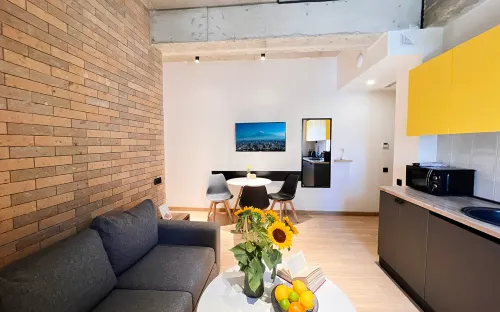
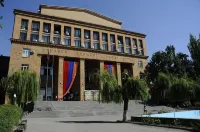





99+
Hotels in Yerevan
Parking
Priority airport pick-up
24-hour front desk
+6
"I’ve never written a bad hotel review ever in my life, but unfortunately, here it goes. It’s a shame since other past reviews are very positive, but I need to be frank and honest about my experience and will be diving the ratings according to subcategories so that it is fair, since some aspects of the stay were great and some not so much.
Check in process: 2 stars
This is not the ‘typical’ hotel entrance where the lobby is on the ground floor. The floor in which you enter is 1/f. The floor of the hotel is 4/f, but this is clearly stated as a signage at the entrance (see photo attached).
Upon arrival, I went towards the hotel entrance . There, I stood in front of an operating system, where guests would need to enter the hotel using a key fob. Of course, I wouldn’t have this key fob at hand at check in. There are no clear instructions in any language above the operator stating how you should call the receptionist using the operator to open the door for you (refer to attached photo). Thankfully, a passerby was kind enough to help me call the receptionist and asked her to open the door for me. It is also better to have mobile data at hand so you can communicate with the staff via whatsapp text/call if you cannot enter, since I think this is the faster means of communicating with guests.
When I checked in, I explained my confusion to entering the building. I told the receptionist lady that I couldn’t enter since there are no instructions in any language above the operator. She then had the audacity to tell me that there ARE indeed instructions above the operator im English, and I should have followed it. Again, the photo I attached shows no such instructions, so I do not comprehend what she is talking about at all.
Upon departure, I voiced out these issues, and the more reasonable receptionists said that they usually send these check in details via email, though I had not received such email(s).
Noise level and disturbance: 2 stars
My room had really thin walls and you can easily hear people passing through in the hallway. I got to a room with a balcony and up until 2 am, I still continuously heard 2 women talking loudly non-stop in the room next to me. To attempt to put a halt to this, I called the receptionist using the calling button thrice in my room, since the initial receptionist lady who checked me in said they provided 24 hour service, and to my dismay, no one bothered answering me.
I had to personally take matters into my own hands and asked them to keep it down.
Room and amenities: 5 stars
In terms of amenities provided within the room and how it was renovated and all, it deserves 5 stars. It was clean and the amenities provided were plentiful for a short stay."
Great
19 reviews
9.2/10
1 night
From 70 AZN
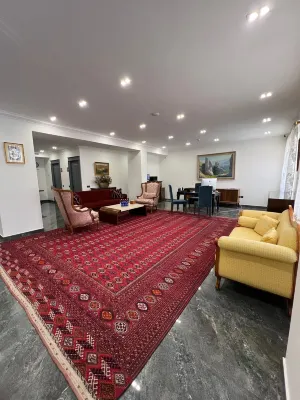
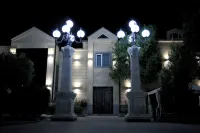



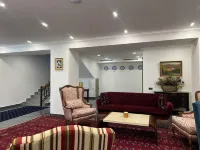
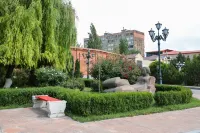
99+
Hotels in Yerevan
Parking
Priority airport pick-up
24-hour front desk
+8
"Отель мне очень понравился. Красивая входная зона, прекрасный номер (высокие потолки, отличный матрац(с), есть всё необходимое - кондиционер, чайник с выбором чая или кофе, холодильник, гигиенические средства, халат). До площади Республики можно дойти за 5-10 минут. С удовольствием вернусь!"
Great
42 reviews
9.3/10
1 night
From 55 AZN
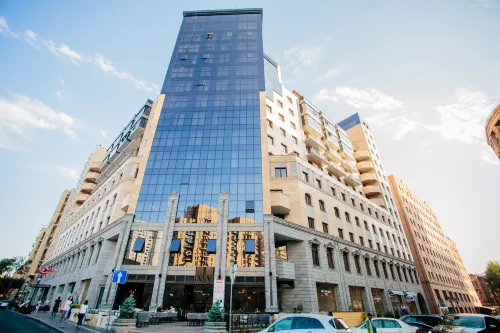
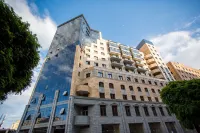


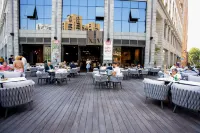


99+
Hotels in Yerevan
Airport pick-up
Airport drop-off
Wi-Fi in public areas
"The location couldn't be better. Right in the center. Sights within walking distance. The room is spacious. Everything you need is there. Feedback is instant. All our wishes were taken into account."
Very Good
42 reviews
8.8/10
1 night
From 61 AZN
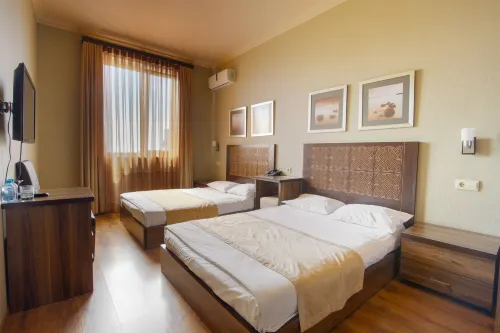
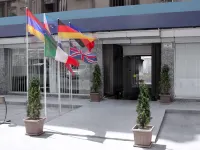





99+
Hotels in Yerevan
Public parking
Airport pick-up
24-hour front desk
+6
"The hotel is located in a residential apartment building. From what I observed, it's about 10 stories high, with floors 7-10 being the hotel, similar to a Chinese B&B. The reception is on the 7th floor, which was very quiet. The room was nice and had a balcony. The hoteliers were very attentive, sending a greeting email not only before check-in but also afterward. I appreciated the thoughtfulness! They strive to meet all guests' needs, allowing guests to cook and wash their own clothes. The breakfast was relatively simple but filling. Since my flight was early and the hotel didn't open until 8:00 AM, I only had breakfast (for my two-night stay) because I had to catch my flight.
The hotel is in a great location, only about 800 meters from Republic Square."
Amazing
54 reviews
9.5/10
1 night
From 30 AZN





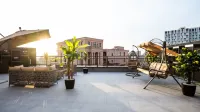

99+
Hotels in Yerevan
Indoor swimming pool
Sauna
Gym
+7
"Очень,очень,очень хорошо!!!Всё понравилось! Место,номер,персонал… Есть небольшие недочёты,но они перекрываются плюсами этого места! Всем рекомендуем!"
Very Good
10 reviews
8.7/10
1 night
From 111 AZN
Trending places in Yerevan
Find top attractions and hotspots in Yerevan
Landmarks
Republic Square
298 hotels
Freedom Square
298 hotels
History Museum of Armenia
298 hotels
Armenian Genocide Museum
298 hotels
Cafesjian Center For The Arts
298 hotels
Browse by hotel type
Immerse yourself in the vibrant atmosphere of Yerevan with our handpicked accommodation options

Premium Hotels in Yerevan
See all
Discover our curated selection of premium hotels in Yerevan for your next stay

No.
1
9.0/10
63 reviewGrand Hotel Yerevan - Small Luxury Hotels of the World
Hotel near Yerevan
"Great location""Friendly host"
Select dates to view prices
No.
2
9.1/10
63 reviewRadisson Blu Hotel, Yerevan
Hotel near Yerevan
"Great swimming pool"
Select dates to view prices
No.
3
8.7/10
69 reviewNational by Stellar Hotels, Yerevan
Hotel near Yerevan
"Great location"
Select dates to view pricesMost-booked Yerevan hotels
See all
Check out these top-booked hotels from the past 30 days!
No.1
7.7/10
54 reviewAlex Hotel
Hotel near Yerevan
"Great stay!""Clean and tidy"
Select dates to view pricesNo.2
8.4/10
89 reviewRoyal Plaza by Stellar Hotels, Yerevan
Hotel near Yerevan
"Great rooms""Great service"
Select dates to view pricesNo.3
9.3/10
52 reviewHoliday Inn Yerevan - Republic Square
Hotel near Yerevan
"Great location""Clean and tidy"
Select dates to view pricesNo.4
9.1/10
55 reviewKantar Hostel
Hotel near Yerevan
"Great stay!""Delicious breakfast"
Select dates to view pricesNo.5
9.0/10
59 reviewYerevan Deluxe Hotel
Hotel near Yerevan
"Clean and tidy""Delicious breakfast"
Select dates to view pricesNo.6
9.1/10
63 reviewRadisson Blu Hotel, Yerevan
Hotel near Yerevan
"Great swimming pool"
Select dates to view pricesNo.7
9.0/10
59 reviewHayasa Hotel Yerevan
Hotel near Yerevan
"Clean and tidy""Friendly host"
Select dates to view pricesNo.8
9.6/10
19 reviewWelcome Inn Hotel
Hotel near Yerevan
"Great rooms"
Select dates to view pricesNo.9
8.7/10
85 reviewRamada Hotel and Suites by Wyndham Yerevan
Hotel near Yerevan
"Great service""Delicious breakfast"
Select dates to view pricesNo.10
8.3/10
2 reviewAreva Hostel
Hotel near Yerevan
"Good Location"
Select dates to view pricesBest Yerevan hotels with breakfast
See all
Start your day with a tasty breakfast at one of our top hotels in Yerevan.
Grand Hotel Yerevan - Small Luxury Hotels of the World
Hotel near Yerevan
With a stay at Grand Hotel Yerevan in Yerevan (Kentron), you'll be within a 10-minute walk of Republic Square and Artists’ Union. This luxury hotel is 0.3 mi (0.5 km) from Museum of the Middle East and 0.3 mi (0.6 km) from National Gallery of Armenia.
Pamper yourself with a visit to the spa, which offers massages. You're sure to appreciate the recreational amenities, including a fitness center and a seasonal outdoor pool. This hotel also features complimentary wireless internet access, concierge services, and a hair salon.
Satisfy your appetite for lunch or dinner at the hotel's restaurant, or stay in and take advantage of the 24-hour room service. Unwind at the end of the day with a drink at the bar/lounge or the poolside bar. Buffet breakfasts are available daily from 7 AM to 11 AM for a fee.
Featured amenities include a business center, complimentary newspapers in the lobby, and dry cleaning/laundry services. A roundtrip airport shuttle is provided for a surcharge (available 24 hours), and free self parking is available onsite.
Make yourself at home in one of the 104 air-conditioned rooms featuring refrigerators and minibars. Flat-screen televisions with cable programming provide entertainment, while complimentary wireless internet access keeps you connected. Private bathrooms with bathtubs or showers feature complimentary toiletries and hair dryers. Conveniences include safes and coffee/tea makers, and housekeeping is provided daily.
9.0/10
Great63 reviewPrice per night from:156 AZN
National by Stellar Hotels, Yerevan
Hotel near Yerevan
With a stay at National by Stellar Hotels, Yerevan, you'll be centrally located in Yerevan, within a 5-minute walk of Republic Square and Singing Fountains. This luxury hotel is 0.3 mi (0.4 km) from History Museum of Armenia and 0.3 mi (0.4 km) from National Gallery of Armenia.
Be sure to enjoy recreational amenities, including an indoor pool, a sauna, and a fitness center. This hotel also features complimentary wireless internet access, concierge services, and a banquet hall.
For lunch or dinner, stop by Kamar Armenian Cuisine, a restaurant that specializes in Modern European cuisine. Dining is also available at the coffee shop/cafe, and 24-hour room service is provided. Relax with a refreshing drink at one of the 2 bars/lounges. Buffet breakfasts are available daily from 7:30 AM to 11:00 AM for a fee.
Featured amenities include dry cleaning/laundry services, a 24-hour front desk, and luggage storage. Planning an event in Yerevan? This hotel has 2378 square feet (221 square meters) of space consisting of conference space and meeting rooms. A roundtrip airport shuttle is provided for a surcharge (available 24 hours).
Make yourself at home in one of the 75 individually decorated guestrooms, featuring minibars and flat-screen televisions. Complimentary wired and wireless internet access keeps you connected, and satellite programming provides entertainment. Bathrooms have designer toiletries and hair dryers. Conveniences include phones, as well as safes and coffee/tea makers.
8.7/10
Very Good69 reviewPrice per night from:123 AZN
Armenia Marriott Hotel Yerevan
Hotel near Yerevan
Armenia Marriott Hotel Yerevan combines modern luxury with rich history in a cultural heritage building in the heart of Yerevan on Republic Square. With charismatic design, sophisticated spaces, and attentive service, this exceptional hotel offers a unique local charm. Following recent renovations, our guests are welcomed into a beautifully reimagined lobby and vibrant new The Square Restaurant and Terrace, perfect for relaxed dining, socializing, or unwinding with a coffee or cocktail. Whether you are traveling for business or leisure, relax in spacious rooms with deluxe bedding and enjoy the convenience of connected room options for families or larger groups with extra comfort and privacy. Enjoy our exclusive Executive Lounge with stunning views of the main square, ideal for private or business meetings. Host flawless events in the largest city spaces, enhanced by expert planners and custom catering. After a full day, rejuvenate in our pool, a serene oasis in the city.
8.2/10
Very Good73 reviewPrice per night from:281 AZN
Golden Palace Hotel Yerevan
Hotel near Yerevan
A stay at Golden Palace Hotel Yerevan places you in the heart of Yerevan, within a 10-minute walk of Republic Square and Artists’ Union. This luxury hotel is 0.4 mi (0.6 km) from Singing Fountains and 0.4 mi (0.6 km) from History Museum of Armenia.
Pamper yourself with a visit to the spa, which offers massages. You can take advantage of recreational amenities such as a health club and a sauna. This hotel also features complimentary wireless internet access, concierge services, and babysitting (surcharge).
Enjoy a meal at the restaurant or snacks in the coffee shop/cafe. The hotel also offers 24-hour room service. Mingle with other guests at the complimentary reception, held daily. Quench your thirst with your favorite drink at the bar/lounge. Buffet breakfasts are served on weekdays from 8:00 AM to 11:30 AM and on weekends from 8:00 AM to noon for a fee.
Featured amenities include complimentary wired internet access, complimentary newspapers in the lobby, and dry cleaning/laundry services. A roundtrip airport shuttle is provided for a surcharge (available 24 hours), and free self parking is available onsite.
Make yourself at home in one of the 36 air-conditioned rooms featuring tablet computers and LCD televisions. Complimentary wired and wireless internet access keeps you connected, and satellite programming provides entertainment. Private bathrooms with showers feature complimentary toiletries and bidets. Conveniences include phones, as well as laptop-compatible safes and desks.
9.4/10
Amazing33 reviewPrice per night from:163 AZN
The Alexander, a Luxury Collection Hotel, Yerevan
Hotel near Yerevan
Introducing an exclusive new address to the city’s developing social landscape, The Alexander is heralded as the first luxury international hotel in the historic center of Yerevan. Each of the 114 non-smoking guestrooms and suites features scaled back, minimalist design, grand gold accents and hints of decorative Armenian motifs. The Alexander’s collection of bars and restaurants attracts Yerevan’s most discerning social scene. An all-day menu is offered at the signature Gabriel’s Bar & Lounge, whilst fine dining venue, Italiano Ristorante, is located on the building’s top floor. The wood-paneled, The Keys Aficionado's Private Club, with handsomely designed bar and glass wine cellar, is the exclusive venue to enjoy a private event, whilst French and Armenian sweet treats can be sampled in the elegant Gabriel's Patisserie, accessible via Abovyan Street.
9.3/10
Great64 reviewPrice per night from:664 AZN
Seven Visions Resort and Places, the Dvin
Hotel near Yerevan
A stay at Seven Visions Resort and Places, the Dvin places you in the heart of Yerevan, within a 5-minute drive of Blue Mosque and Republic Square. This luxury hotel is 1.3 mi (2.1 km) from National Gallery of Armenia and 1.4 mi (2.2 km) from Yerevan Opera Theatre.
Be sure to enjoy recreational amenities, including an outdoor tennis court, a fitness center, and a seasonal outdoor pool. Additional amenities at this hotel include complimentary wireless internet access, concierge services, and shopping on site.
Satisfy your appetite at Hayrik Restaurant, one of the hotel's 3 restaurants. Need to unwind? Take a break with a tasty beverage at one of the 9 bars/lounges. Continental breakfasts are served on weekdays from 7:30 AM to 10:00 AM and on weekends from 7:30 AM to 11:00 AM for a fee.
Featured amenities include dry cleaning/laundry services, a 24-hour front desk, and luggage storage. Free self parking is available onsite.
Make yourself at home in one of the 153 air-conditioned rooms featuring heated floors and Smart televisions. Complimentary wireless internet access is available to keep you connected. Conveniences include phones, as well as laptop-compatible safes and desks.
9.6/10
Amazing59 reviewPrice per night from:434 AZN
Aghababyan's Hotel
Hotel near Yerevan
Located in Yerevan (Ajapnyak), Aghababyan's Hotel is within a 10-minute drive of Hrazdan Stadium and Republic Square. This family-friendly hotel is 4.3 mi (7 km) from Yerevan Cascade and 4.7 mi (7.5 km) from Victory Park.
Relax at the full-service spa, where you can enjoy massages. You can take advantage of recreational amenities such as an indoor pool, a sauna, and a fitness center. Additional features at this hotel include complimentary wireless internet access, concierge services, and an arcade/game room.
For lunch or dinner, stop by Aghababyan's Restaurant, a restaurant that specializes in Eastern European cuisine. Dining is also available at the coffee shop/cafe, and 24-hour room service is provided. Relax with a refreshing drink from the poolside bar or one of the 2 bars/lounges. Buffet breakfasts are available daily from 8:00 AM to 10:30 AM for a fee.
Featured amenities include a 24-hour business center, express check-in, and express check-out. Planning an event in Yerevan? This hotel has 1399 square feet (130 square meters) of space consisting of a conference center and meeting rooms. A roundtrip airport shuttle is provided for a surcharge (available 24 hours), and free self parking is available onsite.
Make yourself at home in one of the 90 individually decorated guestrooms, featuring minibars and Smart televisions. Complimentary wireless internet access keeps you connected, and satellite programming is available for your entertainment. Private bathrooms with separate bathtubs and showers feature deep soaking bathtubs and rainfall showerheads. Conveniences include phones, as well as safes and desks.
8.2/10
Very Good48 reviewPrice per night from:88 AZN
Latar Hotel Yerevan
Hotel near Yerevan
Latar Hotel Yerevan offers top-notch services and amenities, ensuring guests experience utmost comfort.Share your photos and respond to emails at your convenience, thanks to the free Wi-Fi internet access offered by hotel. Should you require transportation to or from the airport, hotel is able to organize it prior to your arrival date.Visitors can take advantage of the accessible parking options directly at the hotel. Traveling with minimal luggage is achievable at Latar Hotel Yerevan due to the hotel's laundry service ensuring your garments stay fresh. Room amenities feature daily housekeeping, allowing you to unwind and make the most of your visit. Smoking is limited to specified smoking zones.Each accommodation at Latar Hotel Yerevan is thoughtfully created and adorned to provide visitors with a comfortable, home-like atmosphere. In certain rooms, the hotel offers linen service, blackout curtains and air conditioning for guest convenience and satisfaction.At Latar Hotel Yerevan, the uniquely tailored rooms provide a configuration choice resembling a balcony or terrace.In select rooms, guests at the hotel can enjoy top-notch in-room entertainment with television, in-room video streaming and cable TV available for their convenience.Rest assured, in a few chosen rooms, you will find the convenience of a refrigerator, bottled water, a coffee or tea maker and instant coffee at your disposal. Maintain your cleanliness and comfort using a hair dryer, toiletries and bathrobes available in select guest restrooms. Experience the delight of a fresh morning by savoring excellent coffee at the cafe situated within hotel. Should you prefer not to venture out for a meal, the enticing culinary choices at hotel are always available for your satisfaction. Experience an unforgettable evening with your fellow travelers just a short distance away, at hotel's bar. Should you be particularly discerning in your dining choices, you will surely appreciate having access to the on-site shared kitchen provided at this location.Latar Hotel Yerevan provides a superb assortment of leisure amenities for guests to enjoy. Unwind after a long day by stopping by massage, hot tub, steam room, spa and sauna to rejuvenate your senses. Each day at hotel, immerse yourself in the invigorating waters of the pool, perfect for a rejuvenating plunge or a series of revitalizing laps. Bypass the formal attire and choose a laid-back mixed drink or brew at hotel's waterside lounge.For individuals who don't want to skip their exercise routine, visiting the hotel fitness center ensures you maintain your vitality and wellness.
9.0/10
Great1 reviewPrice per night from:94 AZN
Red Bridge Yerevan
Hotel near Yerevan
A stay at Red Bridge Yerevan places you in the heart of Yerevan, within a 15-minute walk of Museum History Yerevan and State Museum of Wood-Carving. This hotel is 0.8 mi (1.3 km) from Blue Mosque and 1 mi (1.6 km) from Yerevan Circus.
Take in the views from a terrace and a garden and make use of amenities such as concierge services. Additional features at this hotel include a hair salon and a banquet hall.
Enjoy a meal at the restaurant or snacks in the coffee shop/cafe. The hotel also offers room service (during limited hours). Wrap up your day with a drink at the bar/lounge. Buffet breakfasts are available daily from 8:00 AM to 11:00 AM for a fee. Children aged 12 and younger eat free breakfast.
Featured amenities include dry cleaning/laundry services, a 24-hour front desk, and luggage storage. A roundtrip airport shuttle is provided for a surcharge (available 24 hours).
Make yourself at home in one of the 72 individually decorated guestrooms, featuring minibars and flat-screen televisions. Complimentary wireless internet access keeps you connected, and cable programming is available for your entertainment. Private bathrooms with showers feature complimentary toiletries and hair dryers. Conveniences include desks and electric kettles, and housekeeping is provided daily.
9.7/10
Amazing7 reviewPrice per night from:84 AZN
Republica Hotel Yerevan
Hotel near Yerevan
With a stay at Republica Hotel Yerevan, you'll be centrally located in Yerevan, just a 4-minute walk from Republic Square and 5 minutes by foot from Singing Fountains. This hotel is 0.3 mi (0.5 km) from Museum of Modern Art and 0.3 mi (0.6 km) from History Museum of Armenia.
Pamper yourself with onsite massages or take in the view from a terrace and a garden. Additional features at this hotel include complimentary wireless internet access, concierge services, and gift shops/newsstands.
Enjoy local cuisine at Anoush Restaurant, a restaurant which features a bar/lounge, or stay in and take advantage of the room service (during limited hours). Continental breakfasts are available daily from 8:00 AM to 11:00 AM for a fee.
Featured amenities include a computer station, dry cleaning/laundry services, and a 24-hour front desk. A roundtrip airport shuttle is provided for a surcharge (available 24 hours), and free self parking is available onsite.
Make yourself at home in one of the 56 air-conditioned rooms featuring minibars and flat-screen televisions. Complimentary wireless internet access keeps you connected, and satellite programming is available for your entertainment. Private bathrooms with showers feature rainfall showerheads and complimentary toiletries. Conveniences include phones, as well as safes and electric kettles.
9.5/10
Amazing99 reviewPrice per night from:137 AZN
Latest reviews for Yerevan hotels
See all
Browse these genuine traveler ratings and real guest reviews to find the best Yerevan hotels.
9.4/10
Amazing
Cchow fui ngoGreat location and good breakfast. However, there's only one lift, so expect some waiting. The hotel is undergoing renovations, which makes it a bit messy and dirty.Hopefully, it will look much better once the work is done.
I recently booked a private tour through hotel to visit Khor Virap, Noravank, Tatev Monastery and the Aerial tramway. While I appreciate the arrangement, I wanted to share some concerns about the experience.
The driver did not provide any information about the destinations and only drove us between locations. Additionally, he dud not wear seatbelt, which led to a police stop and issue a fine. This was quite unsetting for us. The trip was cost AMD 99000.00. The driver never offer or stop for lunch and break.
We hope the hotel will take this into consideration to ensure future guests have a safer and more comfortable experience.
9.3/10
Great
GGuest UserThe hotel name is Europe but Asian guests are also welcomed, as I saw Vietnamese or Chinese guests were staying. The room is quite nice and comfortable, bed quality is good and comfy, bathroom is clean, the breakfast is simple but the quality of the each item is nice and has a good combination of nutrition altogether. Hotel clerks are kind, polite and attentive. It is very good hotel and I had pleasant experience.
9.1/10
Great
GGuest UserIt was the most comfortable hotel I stayed in Yerevan
1-Clean, hygienic, especially the bed
2-The front desk lady is super beautiful and the service is very meticulous
The boys on duty at night are also very good, help to call the car to the airport, because I am afraid that it is not safe to go out late at night, and send me out and send me to the car.
3- Order in the room, delivery speed is fast, and the price is a bit cheaper than the outside
4-The location is very good, in the community, quiet, 200 meters away from the underground passage is a medium-sized supermarket~ convenient
5- Convenient transportation, walking distance to all major attractions in the city
6- No check-in time, luggage storage is provided, the luggage will help to send to the room when the time is up
7-Breakfast time is longer, 8:00 to noon, more humane
9.1/10
Great
GGuest UserLocated between 2 Metro Stations, accessible by walk from both. 24 hours running shops are easily found nearby. Room shape is a bit strange but it is very clean and comfortable, shower is strong enough and central heating system works well, bed is comfy, breakfast quality is superb and quite satisfactory, I liked the peach and apricot juice very much.
8.7/10
Very Good
VVLIREVThis was my second stay at this hotel; I wouldn't even consider another! I love everything about it: the staff, from reception to the maid! Special thanks to the girls in the kitchen; they cook delicious food, and there's always a wide selection to suit every taste! They have a great coffee machine with delicious Americano! I'll be back next year.
8.7/10
Very Good
BBoobalan ThangaveluGood location.. nice amenities.. kept clean..
The issue I faced was this.. the next bunk bed upper bed guy complained about packing my bags at 10 am in the morning.. that I am disturbing his sleep..
Mandatory house rules should include people in a Dormitory style MUST NOT COMPLAIN normal activities during normal daytime hours. If one wants to sleep at 10 am in the morning and no one should do anything while that guy is sleeping he should either go to an individual room hotel or put earplugs and sleep all day.. no one would ever cate
8.7/10
Very Good
GGuest User Near the metro station, you can reach the opera for 10-15 minutes.
Clean and beautiful room.
The room had a washing machine (though for the first time it was a little streamed) and a refrigerator.
You can ask for cleaning any day.
Non-obsessive staff.
8.3/10
Very Good
OOlgaArrived at 3 am. They put me in a room where someone was sleeping 😀 . About 30 minutes later they gave me a room. Everything is clean. No extra smells. The guys at the reception during the day are adequate. I wrote everything in advance, it is unpleasant to wait so much at night (for this I took off 1 star). In the room there is a minibar, tea and coffee, a kettle. A robe. In my room for two there was 1 tiny shampoo, 1 tiny shower gel and soap, a toothbrush. A room for two! It was possible to put this for two at least. Total: it takes about 25 minutes to get there by taxi for 1600 money. The bus is 2 km from the hotel. It is not the center. In general, I liked the hotel, good attitude, clean, large rooms. I recommend it. There is also breakfast, I did not try it. Oh! There is a terrace on the 7th floor, a gym.
6.1/10
AAnonymous UserThe hotel is a little far from the city center, but it is convenient to take a taxi. The view is good and you can overlook the city of Yerevan. The hotel facilities are a bit old, but the breakfast is okay.
FAQs About Yerevan Hotels
What is the average price of a hotel in Yerevan for this weekend?
According to the latest 12-month data from Trip.com, the average price for a 3-star hotel in Yerevan this weekend is 108 AZN per night. For a 4-star hotel, the average cost is 186 AZN per night. If you're looking for a luxury experience, 5-star hotels in Yerevan this weekend typically cost 1,165 AZN per night.
How much do hotels in Yerevan cost per night during weekdays?
Based on the latest 12-month data from Trip.com, the average price for a 3-star hotel in Yerevan during weekdays is 111 AZN per night. For a 4-star hotel, you can expect to pay around 181 AZN per night. If you're seeking a luxury stay, 5-star hotels in Yerevan generally cost 1,174 AZN per night on weekdays.
What are the best places to stay in Yerevan?
Some of the best places to stay in Yerevan are near popular attractions like Republic Square, Freedom Square and History Museum of Armenia, offering easy access to key sights and amenities.
What are the best family-friendly hotels in Yerevan?
Families visiting Yerevan often prefer hotels like Plaza Viktoria Hotel Yerevan (from 277 AZN), which are well-known for their family-friendly features of spacious family rooms and child-friendly services.
What are the top hotels in Yerevan near Republic Square?
Some of the top hotels in Yerevan near Republic Square include Yerevan Place Hotel (from 547 AZN), Holiday Inn Yerevan - Republic Square (from 669 AZN) and Ramada Hotel and Suites by Wyndham Yerevan (from 531 AZN), all offering easy access to Republic Square, making them ideal for visitors looking to explore the area.
Where can I find the best hotels in Yerevan?
Yerevan has some of the best hotels for you to select. Whether you're traveling for business or on a vacation, City Centre Hotel (from 230 AZN), Holiday Inn Express Yerevan by IHG (from 482 AZN) and Alex Hotel (from 161 AZN) are preferred hotels.
What's the best pet-friendly accommodation in Yerevan?
Rooftop Apart-Hotel (from 604 AZN) and Apartment on Argishti 15 Street (from 559 AZN) allow pets. Take your pets with you during your stay!
What is the best spa hotel in Yerevan?
Getting tired after a long walk? Doubletree by Hilton Yerevan City Centre (from 544 AZN), Holiday Inn Yerevan - Republic Square (from 669 AZN) and Radisson Blu Hotel, Yerevan (from 538 AZN) provide highly rated spa services.
What’s the best hotel in Yerevan with hot springs?
Wanna experience hot springs in your hotel? Caucasus Hotel (from 333 AZN) has hot springs. Book now!
What are some hotels with pools in Yerevan?
Holiday Inn Yerevan - Republic Square (from 669 AZN), Radisson Blu Hotel, Yerevan (from 538 AZN) and Grand Hotel Yerevan - Small Luxury Hotels of the World (from 741 AZN) are hotels with swimming pools. Stay at any of these hotels to enjoy a swimming pool!
Where can you find hotels with excellent breakfast in Yerevan?
Radisson Blu Hotel, Yerevan (from 538 AZN),Grand Hotel Yerevan - Small Luxury Hotels of the World (from 741 AZN) and National by Stellar Hotels, Yerevan (from 618 AZN) provide high-quality breakfast. Start your day with fresh, delicious breakfast!
Where can I find the best hotel discounts in Yerevan?
Trip.com provides various promotions and discounts for users all year round. You can check the promotions page to see what promotions are available on Trip.com.
Yerevan Hotels Info
Highest Price
1,634 AZN
Lowest Price
63 AZN
Number of Reviews
5,459
Total Properties
306
Weekday Avg. Price
139 AZN
Weekend Avg. Price
139 AZN
Keep Exploring Yerevan
Popular Yerevan Hotels
Sphera by Stellar Hotels, YerevanIbis Yerevan CenterApple HotelSochi Palace HotelCapital HotelFeier hotelArmena HostelCity Centre HotelHayasa Hotel YerevanAlex HotelHotels near Blue MosqueHotels near Cascade ComplexHotels near Yerevan LakeHotels near Swan LakeHotels near Matenadaran - The Museum of Ancient Manuscripts
Popular Yerevan Areas
Popular Cities
Popular Flights to Yerevan
Cheap flights from Dubai to YerevanCheap tickets from Paris to YerevanCheap flights from Milan to YerevanPlane tickets from Macau to YerevanPlane tickets from Hong Kong to YerevanCheap tickets from Tbilisi to YerevanPlane tickets from Singapore to YerevanCheap flights from Bahrain to YerevanPlane tickets from Bangkok to YerevanCheap tickets from Algiers to YerevanPlane tickets from Krabi to YerevanPlane tickets from Moscow to YerevanCheap tickets from Manila to YerevanCheap tickets from Bishkek to YerevanPlane tickets from Colombo to Yerevan
Trip.com Latest Trends
AKaiTiYa Hotels in DaliVacances Bleues Hotels in Aix-les-BainsRakuten STAY Hotels in Kuala LumpurROSEATE HOTELS & RESORTS Hotels in EdinburghNH Collection Hotels in ValenciaZsmart Hotel (Shanghai North Bund Red House Hospital Branch) ReviewsLandison Hotel Penang ReviewsMEILIE Homestay ReviewsRUMAH UNIVERSITI ReviewsBeijing Dongdan Hotel ReviewsGrand Riviera Suites photos, Grand Riviera Suites images, Grand Riviera Suites photo gallery, Grand Riviera Suites guest reviews, Grand Riviera Suites room photos, Grand Riviera Suites amenities list, Grand Riviera Suites interior views, Grand Riviera Suites exterior picturesPeppers Cradle Mountain Lodge photos, Peppers Cradle Mountain Lodge images, Peppers Cradle Mountain Lodge photo gallery, Peppers Cradle Mountain Lodge guest reviews, Peppers Cradle Mountain Lodge room photos, Peppers Cradle Mountain Lodge amenities list, Peppers Cradle Mountain Lodge interior views, Peppers Cradle Mountain Lodge exterior picturesThe Westin Resort Guam photos, The Westin Resort Guam images, The Westin Resort Guam photo gallery, The Westin Resort Guam guest reviews, The Westin Resort Guam room photos, The Westin Resort Guam amenities list, The Westin Resort Guam interior views, The Westin Resort Guam exterior picturesCapri by Fraser Bukit Bintang photos, Capri by Fraser Bukit Bintang images, Capri by Fraser Bukit Bintang photo gallery, Capri by Fraser Bukit Bintang guest reviews, Capri by Fraser Bukit Bintang room photos, Capri by Fraser Bukit Bintang amenities list, Capri by Fraser Bukit Bintang interior views, Capri by Fraser Bukit Bintang exterior picturesVictoria Inn photos, Victoria Inn images, Victoria Inn photo gallery, Victoria Inn guest reviews, Victoria Inn room photos, Victoria Inn amenities list, Victoria Inn interior views, Victoria Inn exterior pictures



